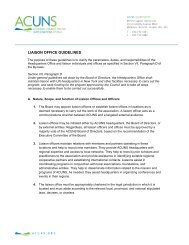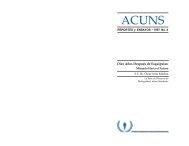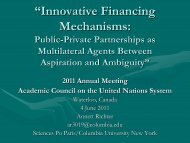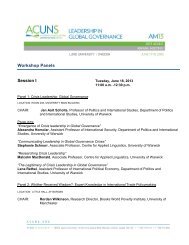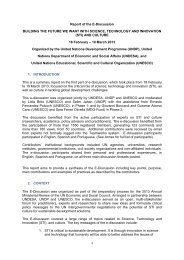THE FUTURE OF NUCLEAR ENERGY TO 2030 AND ITS ... - acuns
THE FUTURE OF NUCLEAR ENERGY TO 2030 AND ITS ... - acuns
THE FUTURE OF NUCLEAR ENERGY TO 2030 AND ITS ... - acuns
Create successful ePaper yourself
Turn your PDF publications into a flip-book with our unique Google optimized e-Paper software.
The Centre for International Governance Innovation<br />
This Overview highlights the key findings of The Future<br />
of Nuclear Energy to <strong>2030</strong> and its Implications for Safety,<br />
Security and Nonproliferation. For the research, analysis,<br />
data and references that support the findings sketched in<br />
this Overview, see the full report at www.cigionline.org.<br />
The Future of Nuclear<br />
Energy to <strong>2030</strong><br />
The Revival so Far<br />
If one dates the revival of interest in nuclear energy from<br />
2000, it is clear a decade later that progress has been<br />
slow. Several countries, notably in East Asia, have begun<br />
building new reactors as part of ambitious nuclear energy<br />
programs, but many others have only announced<br />
intentions or plans, are studying the possibilities or are<br />
simply floating ideas. There has been, in fact, a decline<br />
in the contribution of nuclear power to world electricity<br />
production from 16.7 percent in 2000 to 13.5 percent in<br />
2008. This level was only sustained due to capacity factor<br />
improvements in the existing fleet and extended operating<br />
licences, mostly in the United States. The International<br />
Atomic Energy Agency (IAEA) figure of 436 reactors<br />
as of December 2009 is eight units less than the historical<br />
peak of 444 in 2002. Five nuclear power reactors remain<br />
in long-term shutdown. Since commercial nuclear energy<br />
began in the mid-1950s, 2008 was the first year that no<br />
new nuclear plant was connected to the grid, although<br />
two were connected in 2009.<br />
The industry is struggling to quickly reverse a profound<br />
stagnation that has occurred since the boom years of the<br />
1970s and 1980s. The accidents at Three Mile Island in<br />
1979 and Chernobyl in 1986 led to tightening of regulations<br />
and more prolonged and expensive approval<br />
processes that deterred investment and led to numerous<br />
cancelled orders. Cheaper oil and gas prices, along with<br />
perennially cheap coal, also played against the economics<br />
of nuclear power. The average age of operational nuclear<br />
power plants worldwide is now 25.5 years. Current<br />
Nuclear Reactor Numbers and Share of Global Electricity Production since 2000<br />
18%<br />
460<br />
Percentage of Global<br />
Electricity Production<br />
16%<br />
14%<br />
12%<br />
10%<br />
8%<br />
6%<br />
4%<br />
2%<br />
450<br />
440<br />
430<br />
420<br />
410<br />
Operating Reactors<br />
0%<br />
2000 2001 2002 2003 2004 2005 2006 2007 2008<br />
400<br />
Source: Power Reactor Information System (PRIS), International Atomic Energy Agency. Accessed 3 December 2009. ‘Electricity Generation’ and<br />
‘Nuclear Energy – Consumption’ in Statistical Review of World Energy 2009: Historical data, BP, June 2009.<br />
10 cigionline.org



